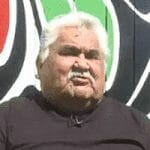Through in-depth community consultations, the establishment of the k̓awat̕si Economic Development Corporation reinvigorated the economic heartbeat of a community.
Reclaiming Control: How the Gwa’sala-’Nakwaxda’xw are Determining their Economic Future
Estimated Reading time

34 Mins
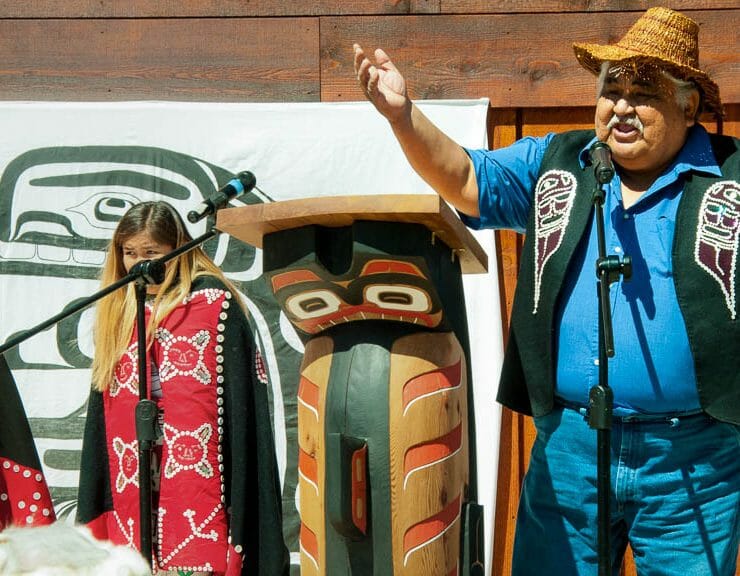
k̓awat̕si Economic Development Corporation is located on the Tsulquate reserve adjacent to the town of Port Hardy.
At a Glance
Decades after a government relocation of two First Nations separated them from their homelands and means of subsistence, the Gwa’sala-’Nakwaxda’xw Nations began developing a plan to return their community to economic self-sufficiency.
Through an in-depth community consultation and planning process, the Nations developed a strategy to support its members through the creation of k̓awat̕si Economic Development Corporation. Within a few short years, the corporation has become an economic force on north Vancouver Island, operating seven distinct businesses and employing, during its peak season, over 130 employees.
By investing in skill development for community members, maintaining a commitment to strengthening culture, and ensuring its businesses enhance the environment, the corporation has become a symbol of the will and strength of the Gwa’sala-’Nakwaxda’xw people, a people who are once again self-determining their economic future.
Four Homes for 200 People – The Relocation of the Gwa’sala and ’Nakwaxda’xw
You can learn a great deal about the Gwa’sala-’Nakwaxda’xw Nations from an 18 square foot copper art piece that hangs in the Nations-owned Kwa’lilas Hotel.
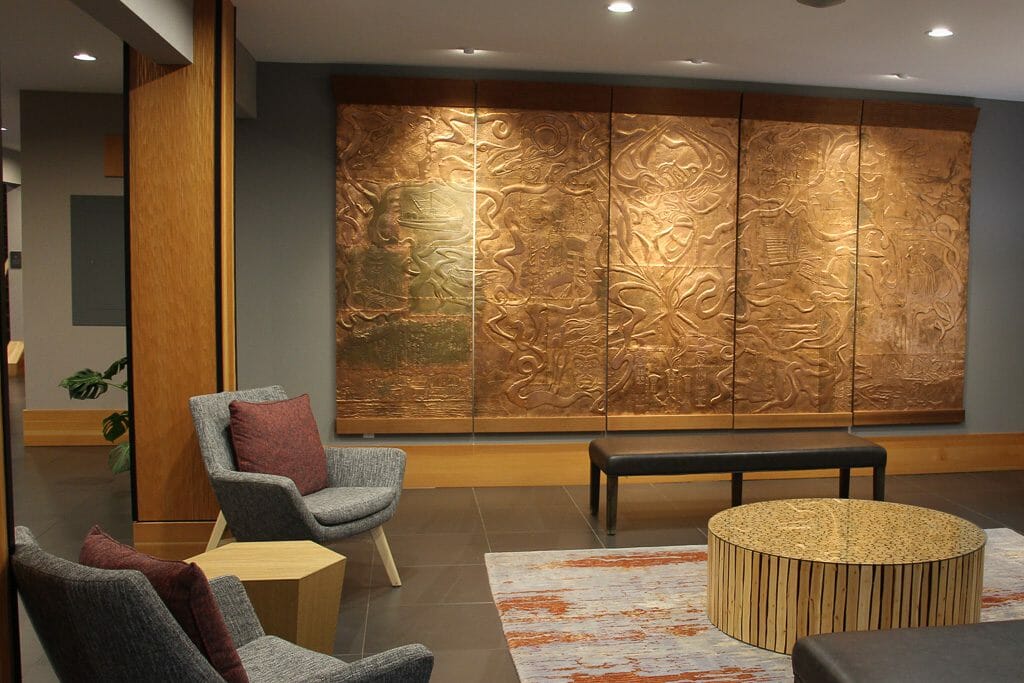
You will see that the two Nations began as close, but distinct groups—the Gwa’sala from Smith Inlet with its central village at Takush, and the ’Nakwaxda’xw from Seymour Inlet and Deserter’s Group, its main village at Ba’as (Blunden Harbour). You will see Dzunukwa, the wild woman of the woods; Willie Seaweed, the great ’Nakwaxda’xw artist; a Big House, not yet built, but envisioned by the Nations; and much more.
But mostly, your eyes will be drawn to the smoke which curls through the entire piece, encompassing all aspects of the Nations’ histories and stories. The smoke, beaten into the copper by artist Shain Jackson, represents the government relocation of the two Nations in 1964. For ease of government administration, 200 Gwa’sala and ’Nakwaxda’xw people were coerced to move from their 350,000 square kilometre territories to Tsulquate, a 0.59 square kilometre reserve outside Port Hardy, that supported a mere four houses.
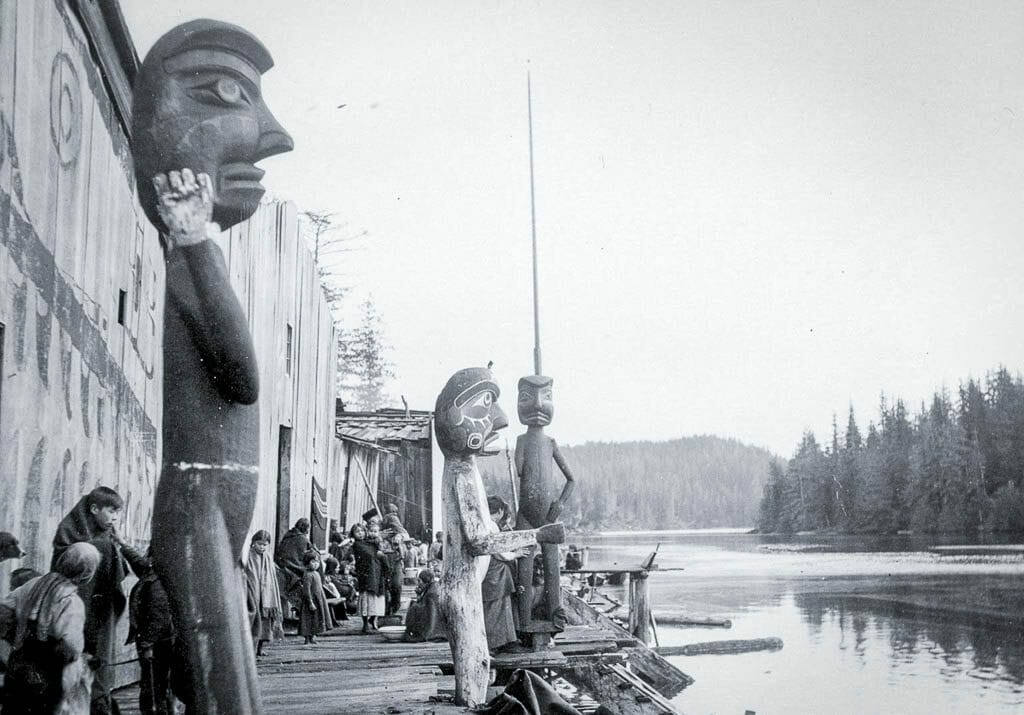
Upon discovering the government had not honoured its commitment to house and provide services to the Gwa’sala and ’Nakwaxda’xw people, the Nations planned to return to their homes at Takush and Ba’as. But before they could, federal Indian agents burned down the villages and with them all the Gwa’sala and ’Nakwaxda’xw belongings, valuables, and regalia. The two Nations had no choice but to start over in Tsulquate, in the traditional territory of another First Nation, with little to their names.
Prior to relocation, the two Nations were self-sufficient. The water and land of their homelands provided the Gwa’sala and ’Nakwaxda’xw with everything they needed including surpluses that were distributed through potlatch or traded with other First Nations. Fishing stations were scattered throughout the region and marine resources like seaweed, seagull eggs, and shellfish were harvested, contributing to the well-being of Gwa’sala and ’Nakwaxda’xw families.
Our homelands have been the sustainer of our lives since time immemorial.
Following relocation, the resources of their homelands continued to provide, only now they provided wealth for private fishing and forestry companies who operated in the region and neglected to share their earnings with the Nations on whose land they operated. Chief Paddy Walkus says the community went through decades of apathy and suffering following relocation and struggled to find ways to subsist in their new home. “It was a struggle,” he recalls, “because we were in an alien environment, not in our traditional territories.”

Community Planning Leads the Way to Economic Revitalization
In 2007, the Gwa’sala-’Nakwaxda’xw Nations won a settlement from the Government of Canada over their forced relocation, amalgamation, and social upheaval to Tsulquate. Although that money has never been used by the k̓awat̕si Economic Development Corporation (KEDC), it created a spark in the community that would eventually lead to the creation of the corporation.
In advance of establishing a trust from the settlement, the Gwa’sala-’Nakwaxda’xw Nations undertook a comprehensive community planning initiative that would establish the vision, objectives and direction for the community. Comprehensive community planning was developed by First Nations in British Columbia in the mid-2000s. Jessie Hemphill, a Gwa’sala-’Nakwaxda’xw member and chair of the KEDC board of directors, says the model is meant to be community-driven, holistic, long-range, culturally grounded, and specific to the community.
We had really active Elders, really active children and youth that took part. So, the final document was a really good representation of that.
Hemphill led the community planning for Gwa’sala-’Nakwaxda’xw, a process which took three years. The planning was an important moment for the community, says Chief Walkus, giving members a feeling of ownership over what was happening in the community. Hemphill says the strength of the final document lies in how well it captures the voice of the community. “The vision really came from them,” Hemphill says. “We had really active Elders, really active children and youth that took part. So, the final document was a really good representation of that.”
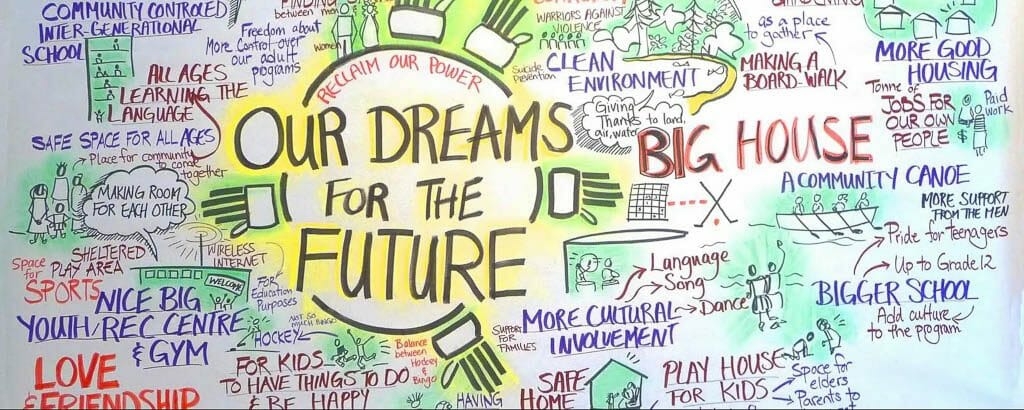
What the community envisioned for its economy was a return to the self-sufficiency it experienced prior to relocation: a community where everyone who wants to work can find a meaningful job.
The planning process provided a road map for the economic future of the Nations. It proved invaluable to Conrad Browne, CEO of KEDC, when, in 2010, he set to work making the community’s vision a reality. Hemphill says Browne ran with the community’s vision from the very beginning, a sentiment echoed by Chief Walkus: “I tried to give Conrad some ideas and he would say ‘No, that’s not in the community plan, we can’t just adjust our plans without consultation.’”
“It was a very good place to start work,” says Browne. “Everything that was important to the First Nations was included in this amazing document.”
From Vision to Reality through Strategy
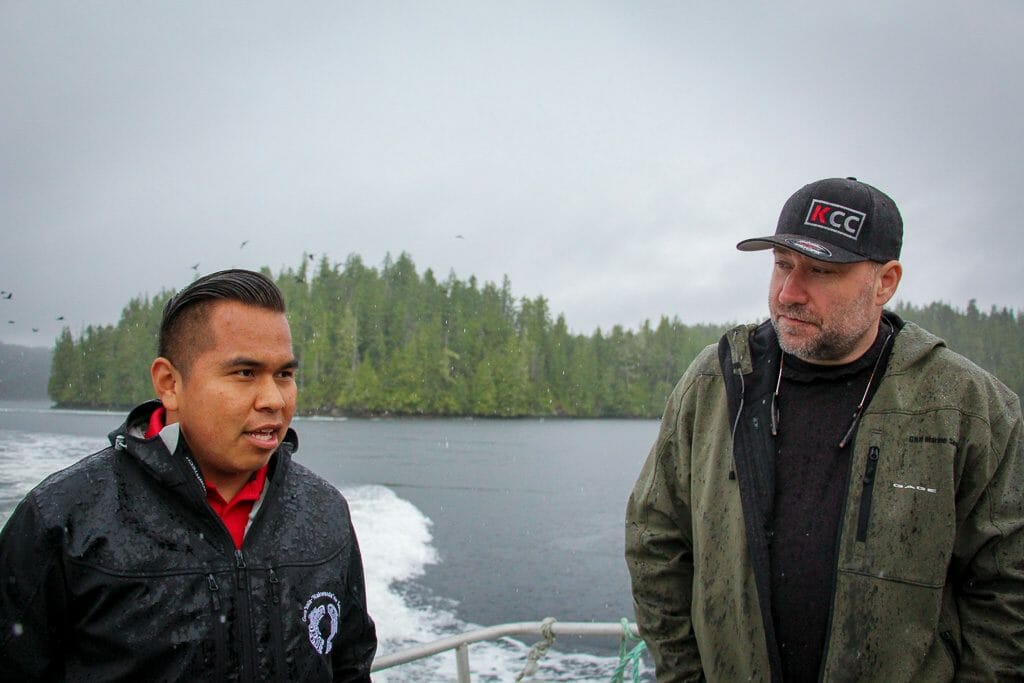
Browne began by turning the broad community vision into a step-by-step plan to create an economic development corporation. “There is a vast expanse between the expressed vision and actually making that vision a reality,” he says. To bridge this expanse, Browne supported Chief and Council to create a strategic plan that would lay out how the Nations could achieve their economic goals.
Hemphill and Browne again worked in close consultation with the community, including several meetings with youth and Elders. This process helped not only to explore the community’s vision, but also to inform and broaden their expectations for what was possible, and consult on potential governance structures.
The strategic plan identified areas of economic potential and wherever possible it focused on a connection to the Nations’ homelands. “Our homelands have been the sustainer of our lives since time immemorial,” the plan states.
The vast territories of the Gwa’sala-’Nakwaxda’xw are full of abundant resources, in the water, the forests, and the land. However, the significant distance to these resources had to be taken into consideration as the Nations planned to develop their economy. Ba’as and Takush are approximately 16 and 60 nautical miles, respectively, from Tsulquate. With this in mind, the strategic plan also looked at economic possibilities in the Port Hardy area including tourism, accommodation, and construction.
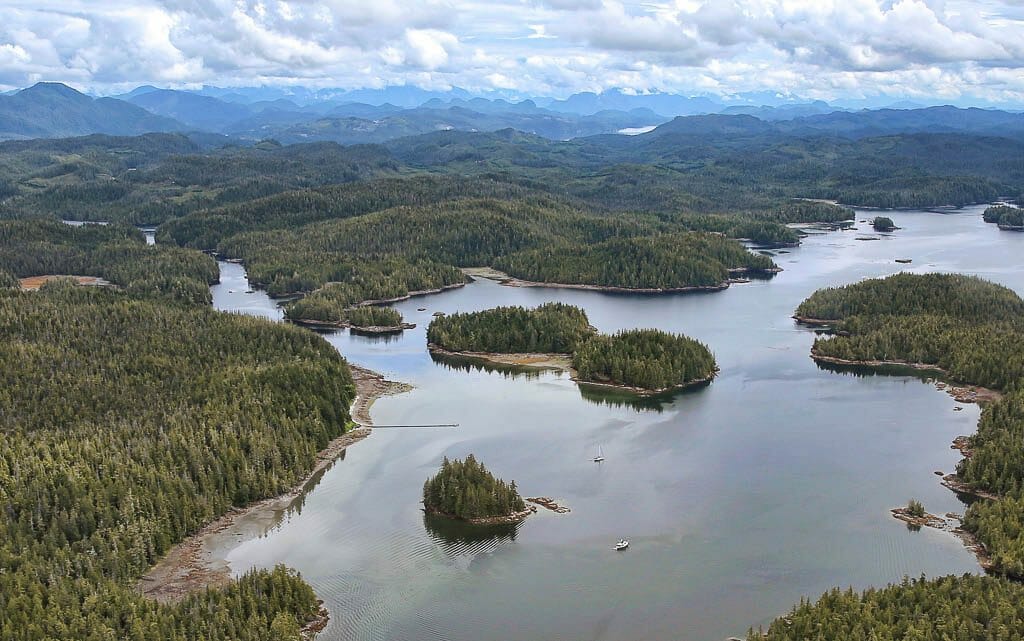
The strategic plan, when it was completed, laid out a step-by-step plan to “create, operate and support businesses that will be profitable, environmentally sustainable and culturally significant, while respecting our unique cultural values, and upholding the pride and wellbeing of the Gwa’sala-’Nakwaxda’xw people.”
A number of guiding principles were established including that businesses owned by the corporation will be profitable; enhance the culture and values of the community, enhance the environment; create employment opportunities, support skill and capacity development, and improve and enhance the community’s self-sufficiency.
By 2012, the Gwa’sala-’Nakwaxda’xw Nations were ready to lay the cornerstones of the k̓awat̕si Economic Development Corporation.
Laying the Foundation
After spending years planning and engaging with the community, Browne began engaging several contractors to support the Gwa’sala-’Nakwaxda’xw Nations as they developed k̓awat̕si Economic Development Corporation (KEDC). One of the key notions raised in the comprehensive community planning, and re-emphasized in the strategic planning engagement, was that the community wanted to ensure a separation of business and politics.
Chief Walkus says this decision—following the best practices established by the Harvard Project on American Indian Economic Development—allowed the Nations to prevent economic decisions from becoming a “political football,” being pushed back and forth between the community and Chief and Council. “That was one of the real critical components of what happened,” says Walkus.
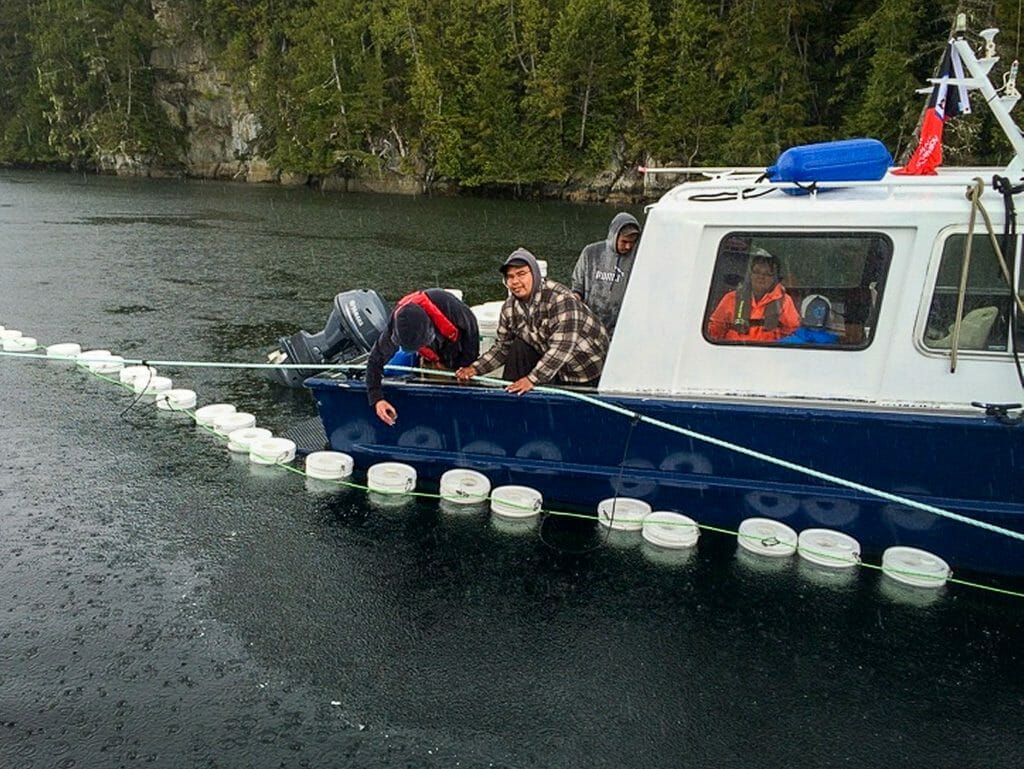
Browne enlisted Meyers Norris Penny (MNP) to help establish the corporate structure that would ensure Council has no direct involvement in business management, thus protecting their assets from risk in case of liability. The structure developed five limited partnership companies operating under KEDC. The separation also ensures that business operations won’t be unduly affected by changes in elected leadership.
The structure developed by MNP enables that the Gwa’sala-’Nakwaxda’xw Chief and Council to hold shares of KEDC in trust on behalf of their members. Chief and Council also appoint directors to the k̓awat̕si board of directors, and that board of directors oversees business operations. Each KEDC business is set up as a subsidiary corporation in order to protect from potential liabilities.
Both Browne and Hemphill agree the importance of a separation between a Nation’s elected representatives and its economic development corporation; however, they both see the Harvard model as perhaps overly rigid and unrealistic about how communities operate.
“It’s a tricky thing. The Chief and Council are elected to represent the community and have the best interests of the community at heart,” says k̓awat̕si board chair Jessie Hemphill. “Because of course they’re the ones getting the phone calls and requests from the community about jobs available and a lot of different issues.”
The strategic plan is an important piece because it allows Chief and Council to have some input into how the businesses are moving forward.
To allow for some flexibility while still maintaining a legal separation Chief and Council meet regularly with the KEDC board of directors to contribute to the strategic planning process and stay up-to-date on KEDC activities. “The strategic plan is an important piece because it allows Chief and Council to have some input into how the businesses are moving forward,” says Browne. The board also offers one council member to sit ex-officio in the board meetings so that they can effectively communicate with Council.
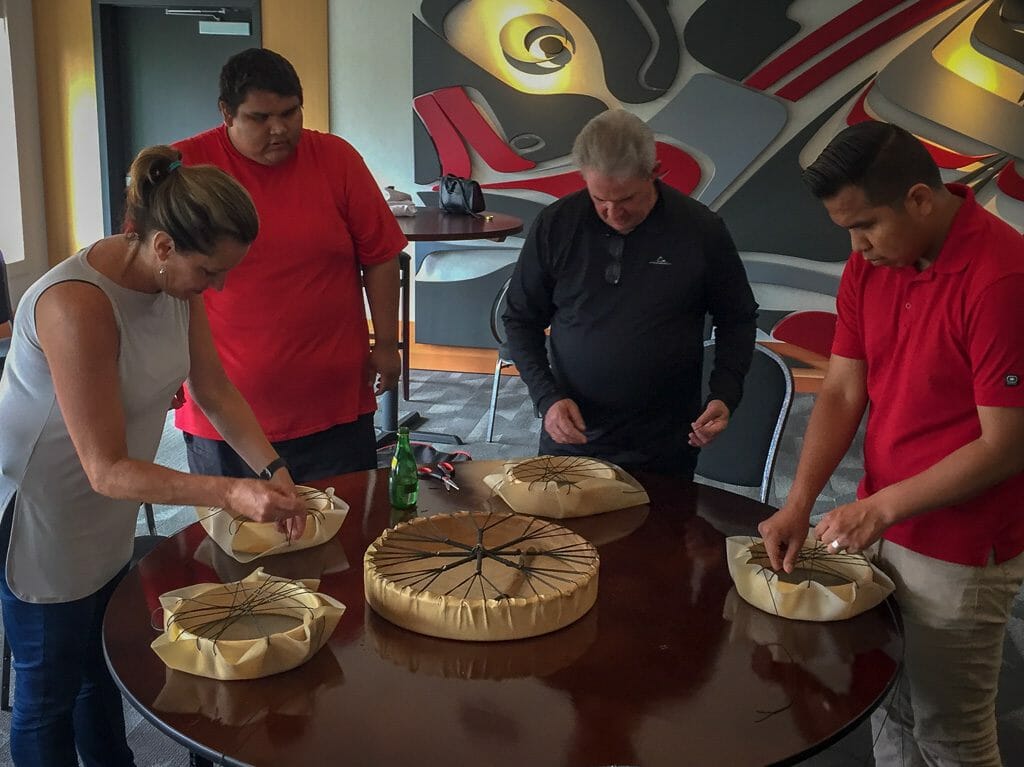
Hemphill emphasizes the process is a work in progress and the board is always working to improve communication with Council: “We’re trying to get better at it—it takes a lot of work.” Since becoming chair, Hemphill has established more frequent in person meetings with Chief and Council.
To ensure best communication practices, Browne worked with FleishmanHillard on a communications plan. Browne says that building in two-way communication to all aspects of the corporation’s work helped them gain the trust and support of the community during a time of rapid growth and change.
Browne continued to host public meetings and sit down with Elders on a regular basis, making space for community members to be informed and provide feedback. Additionally, as he developed the corporation (and still to this day), Browne utilized the community newsletter, Yo! News, to distribute information to community members.
In December 2014, k̓awat̕si Economic Development Corporation officially incorporated, and the following month they were in business.
Creating Community-Supporting Businesses
Over the three and a half years that have passed since incorporation, k̓awat̕si Economic Development Corporation (KEDC) has seen substantial growth. “We started with one person and one boat and at the highest part of our season [in 2017] we had 130 employees across seven distinct businesses,” says Browne. “They’ve been working their tails off for the last few years to make us into a profitable corporation with multimillion-dollar revenue.”
I really believe it provides a lot of drive, especially in our young people. They’re looking beyond the current horizons and that is exciting for all of us.
True to their guiding principles, the businesses operate profitably, create employment, and benefit community members, the environment, and the culture and values of the community. Each of these businesses serves as a source of pride for community members, and a source of hope.
Chief Walkus has led the Gwa’sala-’Nakwaxda’xw Nations for the last 35 years. He sees the work being accomplished by k̓awat̕si Economic Development Corporation as a source of inspiration for his community. “I really believe it provides a lot of drive, especially in our young people. They’re looking beyond the current horizons and that is exciting for all of us,” Walkus says.
Fisheries

The corporation’s cold storage facility effectively filled a storage shortfall on the north island by providing 2.2 million pounds of cold storage capacity. The facility is managed by Albert Charlie who works tirelessly to oversee the facility’s operations and prepare the space to house a fish processing plant and a blast freezer.
The k̓awat̕si Economic Development Corporation is committed to supporting employees like Charlie, a Gwa’sala-’Nakwaxda’xw member, by providing skills training to allow them to grow into and stay in managerial positions. Charlie loves the work, describing it as his dream job, and is grateful for the opportunity to develop skills that will prepare him for the growth of the business.
The corporation’s aquaculture branch focuses on growing scallops and oysters, considered a sustainable form of aquaculture. Located in the Nations’ territories, the projects provide sustainable economic opportunities for the community and offer a potential means of livelihood for community members who may wish to return to live in the homelands.
Construction
The cold storage facility and the Nations-owned Kwa’lilas Hotel and Pier Side Landing, were both built or renovated by KEDC’s construction business—k̓awat̕si Construction. The company has also conducted numerous builds and renovations on Tsulquate reserve, a process which requires a successful bid.
Transportation
K̓awat̕si Marine is a water taxi service that operates in the traditional territories of the Gwa’sala-’Nakwaxda’xw Nations. The company owns and operates five vessels—three water taxis, a full-sized camp services boat, and a landing craft.
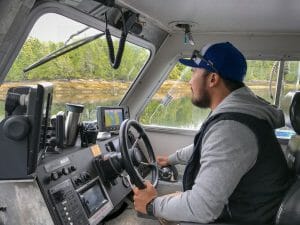
Eddie Walkus, a Gwa’sala-’Nakwaxda’xw member, manages the water taxi company. Prior to starting work for k̓awat̕si Marine, he worked driving trucks on Vancouver Island. Walkus is thankful to have a position that allows him to spend so much time on the water and in the homelands. Through the work he is also able to support community members who want to travel to their homelands—the company sets aside some free trips for Elders and youth, and provides discounted rates for community members and staff.
Hemphill is proud of the role the water taxi business has played in helping members get out on the water: “We’ve been able to empower a whole new generation of Gwa’sala-’Nakwaxda’xw youth and Elders to reconnect with their homelands and have that access we didn’t have before.”

Forestry
After decades watching Gwa’sala-’Nakwaxda’xw forests logged by outside companies with little-to-no benefit returning to the Nations, KEDC started Gwanak Resources—a Gwa’sala-’Nakwaxda’xw -owned company that holds and manages all forestry licenses owned by the Nations.
The business, managed by Browne, who worked in the industry for many years, employs community members with intimate knowledge of the region.
Tourism
The water taxi boats and staff are shared by k̓awat̕si Tours, the corporation’s tourism business. The company offers a variety of eco-tours in the nearby region and the Gwa’sala-’Nakwaxda’xw homelands as well as a number of cultural experiences, including cedar weaving, drum-making, and the opportunity to listen to an Elder’s story or witness cultural dances.
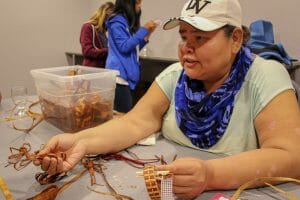
Thomas Coon is a tour guide and the coordinator for k̓awat̕si Tours. He loves teaching visitors about his community and his territories. He keenly remembers the first tourists he took to Ba’as—a couple who had never before seen the ocean. Coon talked to them about the relocation of the ’Nakwaxda’xw people and searched with them for glass beads amongst the shell middens that are all that remain from the community that once thrived there.
Accommodation
The k̓awat̕si Economic Development Corporation owns two hotels in Port Hardy: Kwa’lilas Hotel and Pier Side Landing. “I think the Kwa’lilas Hotel is such an enormous source of pride for the community,” says Hemphill. The hotel is a grand statement of the Gwa’sala-’Nakwaxda’xw people, their culture, and their ability to thrive. Art from the community, including a series of beautiful masks, is found throughout the hotel.
“I think when you consider what an impossible dream it seemed to have a hotel in 2010 when we were just wrapping up the community planning…to go from that to within five years having something as beautiful and as powerful a visual symbol of our identity is inspiring in so many ways,” notes Hemphill.
Challenges and Lessons Learned
After years of planning, engaging, strategizing, and implementing, the Gwa’sala-’Nakwaxda’xw have a successful economic development corporation to drive growth in their community, provide jobs for locals, revitalize culture, and help reconnect members to their homelands. They have learned much along the way and offer the following advice:
Engage with and Learn from Elders
“If there’s one secret I’d pass on, it’s that whoever is trying to make change in the community had better have the Elders onside or else it’s going to go nowhere,” says Conrad Browne. Hemphill agrees that the strength of k̓awat̕si Economic Development Corporation (KEDC) comes from creating time and space to engage with and learn from the Elders. She suggests beginning to work with Elders at the earliest possible stage of planning and continuing to work with them throughout development.
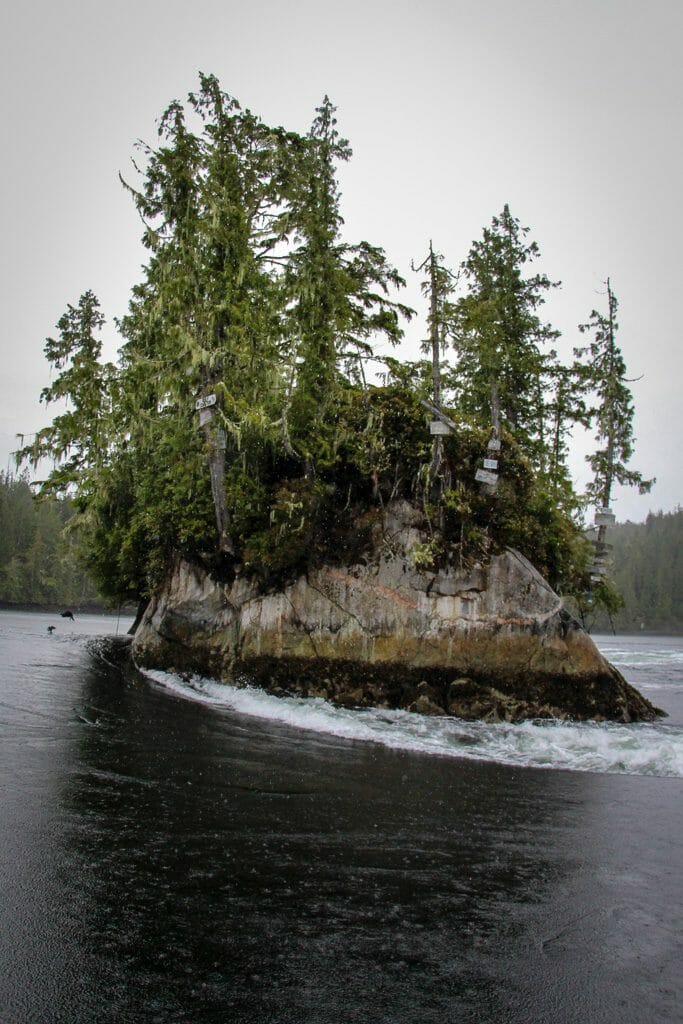
Working with Chief and Council
Finding a balance between independence and accountability has been an ongoing process for KEDC. Both Hemphill and Browne maintain the necessity of open and frequent communication between the board and Chief and Council.
Hemphill suggests that what works in her community, might not be the right fit for another, emphasizing the importance of considering community context. Separation of business and politics is important, she notes, but wishes there had been more information available during planning to understand other options available for working with Chief and Council. “Being able to talk through the pros and cons of the other options would really have helped,” she says. “Because I think it’s a lot harder to change them once you’re operating.”
Communication and Community Engagement
Hemphill says one of the themes that arose during comprehensive community planning was that community members felt out of the loop. “In a lot of the cases, the problems they were facing were due to the communication in the community more than anything else,” she says. The importance of communication, say both Hemphill and Browne, can’t be overstated.
Hemphill advises that communication with community members, Chief and Council, and any other stakeholders, must be frequent and bi-directional. She likens healthy communication to a circulatory system: “The output constantly needs to be created and the input evaluated, like a living thing.” She also encourages communicators to keep in mind literacy levels of readers to ensure that as many individuals are engaged as possible, including youth and children.
If there’s one secret I’d pass on, it’s that whoever is trying to make change in the community had better have the Elders onside
The Ecosystem of Plans
Communication extends beyond stakeholder engagement and into planning and strategy development. Hemphill refers to this as the “ecosystem of plans.” Planning documents and evaluation mechanisms, she suggests, should each feed into one another in ways that enhance their strength and quality. If the “ecosystem” is healthy the comprehensive community plan informs the economic development strategic plan, which informs annual strategic planning, which informs work planning. Work planning is monitored and the results get fed back into each of the higher levels.
Communication, Hemphill says, is the system that moves information throughout the ecosystem. “Communication helps ensure that the plans go into one another and the folks that created each one of those levels, including the community, knows that their vision and goals are being implemented throughout the levels. And then you’re looking at the community as a living thing that needs care and attention rather than looking at these plans as static documents.”
External Experts
Besides the knowledge Hemphill, Browne, and others brought to the start-up of k̓awat̕si Economic Development Corporation (KEDC), Browne says working with external contractors to utilize their experience and expertise was essential.
KEDC worked with MNP to develop the corporate structure and all of their policies. Woodward and Company was chosen by Browne to be the law firm that would represent the corporation. FleishmanHillard worked with KEDC to develop communication plans and policies.
We used to worry that there weren’t enough jobs, but now we have dozens of jobs but we’re having a hard time filling them.
Investing in Staff and Personnel
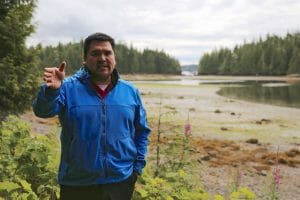
Hemphill encourages other Nations who might be developing or who already have economic development corporations to invest early and often in community members and existing staff. Investing in their education, professional development, and helping them grow into the managerial roles will pay off in the long-term, she says.
Finding technically qualified personnel can often be a struggle in smaller and more remote communities. “We used to worry that there weren’t enough jobs, but now we have dozens of jobs but we’re having a hard time filling them,” Hemphill says.
Board Diversity
Hemphill encourages those in the process of developing a board of directors to consider diversity of demographics and skill sets. KEDC reserve three out of their five board of director positions for Gwa’sala-’Nakwaxda’xw community members, while the others have gone to individuals from a variety of backgrounds.
“You get a lot of benefit out of creating a diverse board and to do otherwise is selling [y]ourselves short. There’s a lot of internalized patriarchy in the business community and in colonized communities. We have to work hard against that,” says Hemphill.
The End Goal is a Strong-Skilled Community
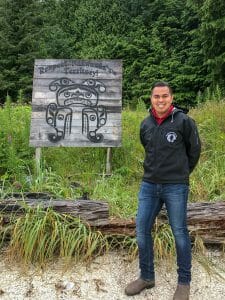
Hemphill encourages Nations and economic development corporations to recognize that their work extends beyond the infrastructure it creates. “It’s the people that work in those places, it’s the administrative processes in place, it’s the good governance, it’s the communities,” she says. Building soft skills and developing support systems will, in the end, make or break a corporation and its businesses. “I think the planning, communication, facilitation skills, just interpersonal relationship skills are as essential to a healthy economic development corporation as entrepreneurial skills or financial knowledge or marketing experience,” says Hemphill.
Consideration of Local Communities
Because Gwa’sala-’Nakwaxda’xw Nations were relocated to Tsulquate, a significant portion of their economic development business takes place on the territories of the Kwagu’ł. KEDC invites Kwagu’ł hereditary chiefs to bless an area before it begins development.
Planning, communication, facilitation skills, just interpersonal relationship skills are as essential to a healthy economic development corporation.
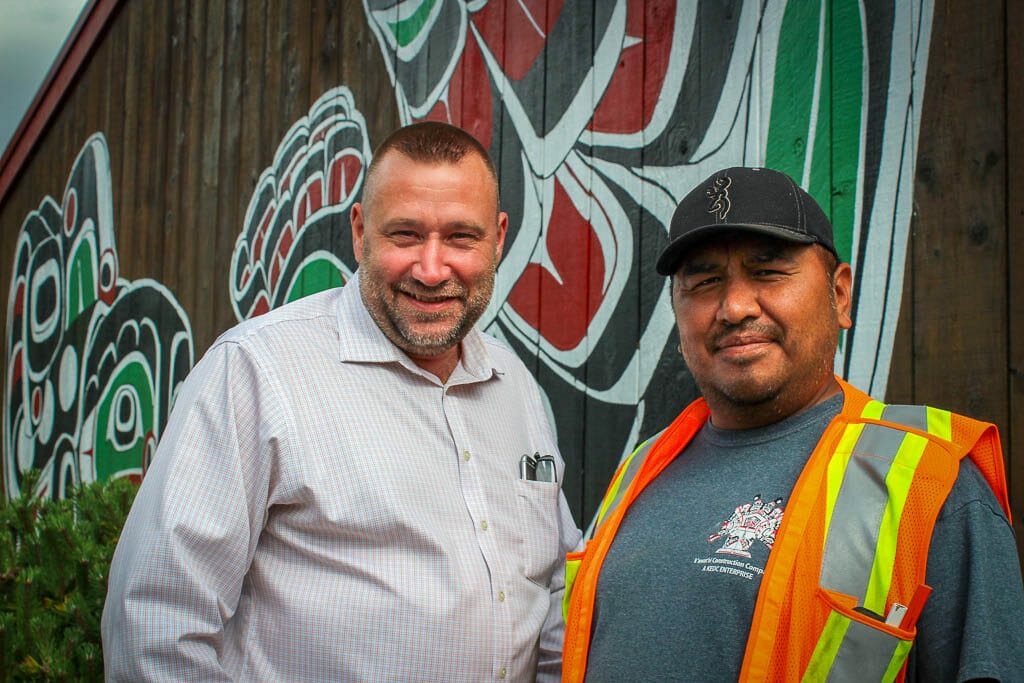
Economic Outcomes
The Gwa’sala-’Nakwaxda’xw Nations are growing and diversifying their economy through the start-up and operation of k̓awat̕si Economic Development Corporation (KEDC). Eight new businesses have been created, including the economic development corporation, five limited partnerships, and two businesses (Pier Side Landing and Kwa’lilas Hotel) which are housed under one of the limited partnerships.
Together, these projects have leveraged over $15 million, invested almost entirely into permanent new infrastructure.
As well as their own community, the corporation has benefited the economy in the District of Port Hardy. Leightan Wishart, a councillor for the District of Port Hardy says the k̓awat̕si Economic Development Corporation is a valued employer in the north island: “They have made significant investments in Port Hardy and appear to be very successful and busy,” says Wishart. “With their businesses, the local tourism has increased to the benefit of Port Hardy and local residents.”
Learn more about diversification outcomes.
Environmental Outcomes
Gwa’sala-’Nakwaxda’xw Nations’ community values around environmental sustainability were a clear theme throughout the comprehensive community planning process, and the economic development strategic plan. One of the guiding principles developed through the economic development strategic plan is that businesses will enhance the environment.
“Conrad has worked really hard to make sure that our businesses have that awareness,” Hemphill says. As an example, she points to the three floating barge camps in the homelands: Bear Den, Raven Call, and Wolf Song. The barges, operated under the k̓awat̕si Marine Services LP, have desalination plants and run on solar power. “We’re trying to make them off grid and not so reliable on fossil fuels.”
Additionally, KEDC’s water taxi business shares its boats with the Nations’ Guardian Watchmen program, thus providing the infrastructure that allows for better monitoring of and an increased presence in the Gwa’sala-‘Nakxwaxda’xw homelands.
Learn more about environmental conservation outcomes.
Social Outcomes
The start-up and operation of the k̓awat̕si Economic Development Corporation (KEDC) and its businesses has resulted in the creation of 167 permanent new jobs, over 80% of which are held by First Nations employees. Some of the jobs include crew boat operator, remote camp services operator, cultural tour guide, forestry worker, bookkeeper, marine service manager, cold storage manager, and hospitality staff.
Significant training has contributed to the success of KEDC businesses. Over 100 people have received a combined total of 3,625 training days in areas including construction, tourism, administration, hospitality, and management.
Learn more about training outcomes.
Cultural Outcomes
The contributions KEDC has made to revitalizing and supporting the culture of Gwa’sala-’Nakwaxda’xw Nations have been multi-faceted. Cultural assets are being protected through the display and creation of art in Kwa’lilas Hotel while infrastructure developed by KEDC has allowed for an increased presence in the homelands. For example, Elders and other community members are empowered to reconnect with their homelands through free and subsidized trips through the k̓awat̕si water taxi business.
Oral histories and customs are being passed down from Elders to cultural tour guides working for KEDC’s tourism business and the Kwak’wala language is used in business names including the economic development corporation’s name, k̓awat̕si, which refers to the painted bentwood box communities have used to house their treasured possessions.
Finally, the cold storage facility provides community members with access to store fish for their food, social and ceremonial use, while the menu at Ha’me in Kwa’lilas Hotel showcases local and Indigenous ingredients.
Learn more about cultural assets outcomes.
Contacts
Between 2010 and 2017, Coast Economic Development Society approved funding for five projects totalling $1,907,007 toward the start-up and operation of Gwa’sala-’Nakwaxda’xw Nations’ k̓awat̕si Economic Development Corporation.
Online Resources
- k̓awat̕si Economic Development Corporation
k̓awat̕si Economic Development Corporation Webpage - Gwa'sala-’Nakwaxda'xw Nations
Gwa'sala-’Nakwaxda'xw Nations - Gwa'sala-’Nakwaxda'xw History and Vision
More about the Gwa'sala and ’Nakwaxda'xw Histories - k̓awat̕si Tours
KEDC’s Tourism Company - K̓awat̕si Fisheries
KEDC’s Fisheries Company - Cold Storage
KEDC’s Cold Storage Business - k̓awat̕si Construction
KEDC’s Construction Company - Gwanak Resources
KEDC’s Forestry Company - k̓awat̕si Marine
KEDC’s Marine Transportation Company - Kwa’lilas Hotel
Kwa’lilas Hotel - Pier Side Landing
Pier Side Landing - Ha’me Restaurant
Ha’me Restaurant in Kwa’lilas Hotel - Comprehensive Community Planning
Community Planning resources and workshops - The Harvard Project on American Indian Economic Development
The Harvard Project on American Indian Economic Development - https://issuu.com/gwanak
The Gwa’sala-’Nakwaxda’xw community newsletter - The Relocation
Indigenous Arts and Stories, 2013 - Shain Jackson
Artist who created copper art in Kwa’lilas Hotel - How a People Live
Documentary about Gwa’sala-’Nakwaxda’xw Relocations - Gwa'sala –’Nakwaxda'xw Videos
A series of videos about Gwa'sala - ’Nakwaxda'xw Nations and k̓awat̕si Economic Development Corporation - Blunden Harbour
Documentary from 1951 exploring the culture and lives of the ’Nakwaxda’xw at Ba’as (Blunden Harbour) - Navigating the fastest tidal surge in the world is part of First Nations history
Global News, April 2016 - k’awat’si Marine Transport celebrates a growing fleet with a blessing from community
BC Local News, November 2020
Published On August 8, 2018 | Edited On January 23, 2023


